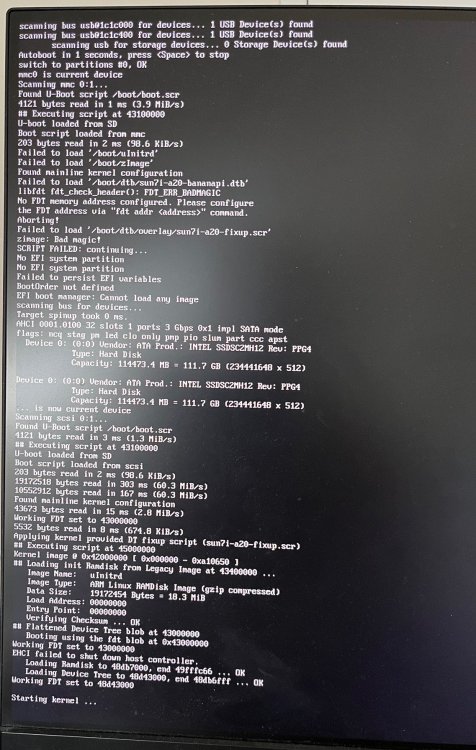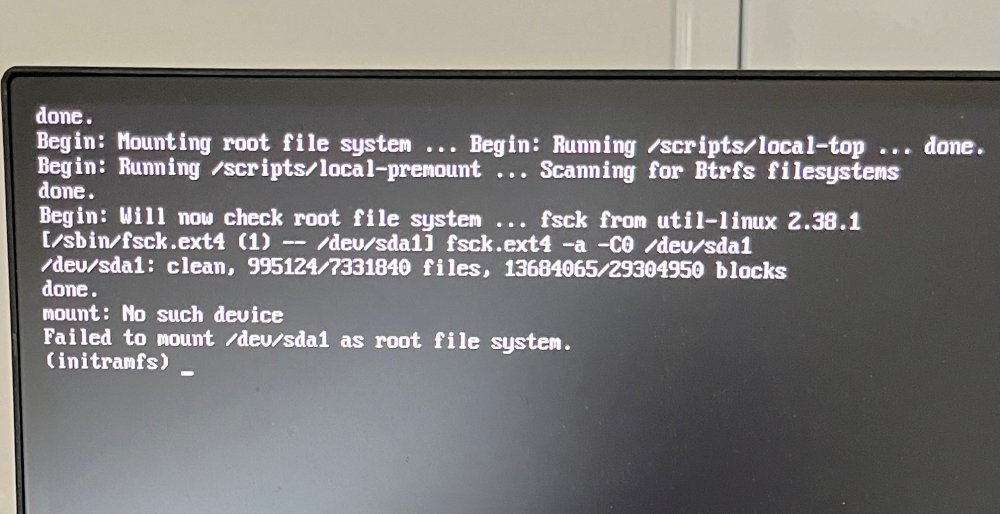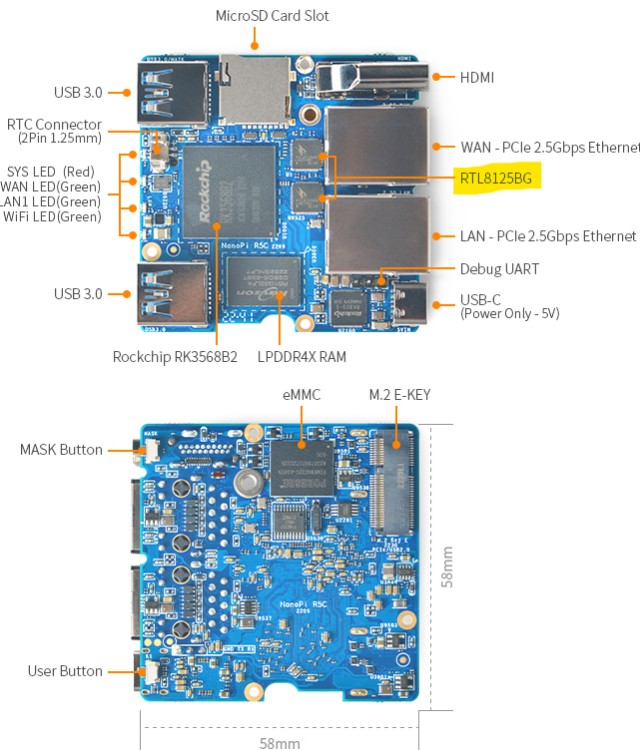All Activity
- Today
-
Hi Loeriver, Where is the other end of your USB serial dongle connected to? Can you check there if the dongle had disappeard from the USB bus and re-appeared around the same time? In my "professional" life we have had workstations mysteriously reboot whenever we would power cycle the device hosting the USB to serial device. Even though you say it's not related, if this is still mysterious, best to check under each stone... Groetjes,
-
Thank you for this very helpful hint. I have installed auditd, I thought I have to systemctl (start, enable) auditd also to have it watching: but this seems to have been done by the install cmd already, as it is running. As I saw a burst of 7225 (!) sysrq messages in the log for 2025-06-18, between 08:55 and 09:50 again I am rather nervous about this topic. Since then no new messages again. Mysterious ... Greetings.
-
I just found one weird setting on R6S. Can you provide what is in this file: cat /etc/udev/rules.d/70-persistent-net.rules Reference for what to do: https://github.com/armbian/build/pull/8325
-
From the picture - I can only guess that kernel package was somehow not upgraded properly as kernel image files are missing. Perhaps they were removed by accident or there was some disk / file system troubles involved. @Chris007 Try hints from here: https://docs.armbian.com/User-Guide_Troubleshooting/
-

BananaPi M1 failed boot after armbian-upgrade
Chris007 replied to Chris007's topic in Allwinner sunxi
From SSD -

Help wanted to test a new OpenVFD alternative
Jean-Francois Lessard replied to Jean-Francois Lessard's topic in Amlogic meson
@KrzyPacu try with hk1-box.dtso instead: make hk1-box.dtb cp release/hk1-box.dtb /boot/dtb/{YOUR_DTB_PATH}.dtb reboot hk1-box.dtso has the same configuration as hk1-x3.dtso but with pins 63/64 instead 64/65. Original OpenVFD specify "Vontar X3" in hk1-box, not hk1-x3. If that still doesn't work, you need to start from a known working configuration, either OpenVFD or original Android firmware dtb. Then you can work backwards to understand your configuration and create the proper dtso. -

BananaPi M1 failed boot after armbian-upgrade
eselarm replied to Chris007's topic in Allwinner sunxi
Somehow the SD-card contents and SSD contents could be mixed-up or partly double. I do not know what armbian-update does, but what is your plan or what do you want? Should Armbian run from SD-card or SSD? -

Cubieboard 1 - No display output when booting Debian 12 image
Nasko replied to Shakai2's topic in Allwinner sunxi
Same Here. I am using Armbian on top of cubietruk as cups print server for years without issue. Now I have decided to see if I can use scanning function of my Samsung SCX-4600 3 in 1 machine. So, I logged in via ssh to my cubietruk running Armbian 23.02.0-trunk Lunar and I just did sudo apt-get update (And got some errors of missing repos), Despite that I have decided to give a try with sudo apt-get install sane Result was 5-6 missing packages Next obvious step was to start armbian-config and I went directly with "Update firmware and packages" Update was success and armbian-config asked for a reboot, which I did. Unfortunately the system was not able to boot. Luckily I have 23" HP Z-series monitor next to my trusty SBC and saw that on the console was lots of errors related to ETHERNET. Second and third reboot was pointles, so I have decided that It is time for fresh install for my cusps print- server. I have downloaded "Debian 12 (Bookworm)Minimal / IOT" from https://www.armbian.com/cubietruck/ and I have flashed it using dd. Next obvious step was to start the system. I saw U-Boot Logo and "Starting Kernel" Then the screen went BLACK. NOTHING. Now there is no way to configure this fresh install. Is there any workarounds? -
Ach, OK. On Banana Pi M4 Zero (H618), the Ethernet PHY is integrated into the SoC, specifically within the AC200 block. There is no external Ethernet PHY chip like RTL8211F — the EMAC1 interface uses RMII and talks directly to the internal PHY. The issue I’m facing is likely due to incompatibility with kernel 6.x.x. I haven’t been able to get any overlay to work properly. However, with a kernel from the 5.4.x series, Ethernet works out-of-the-box on the same hardware. Any insights on proper overlay structure or required patches for AC200 support in newer kernels would be highly appreciated. Thanks for your help!
-

How install Armbian to tvbox Ugoos SK1 ( chip S928X-K )
Werner replied to Nguyễn Tất Hùng's topic in Amlogic CPU Boxes
Okay, then you have to adjust the source to mitigate the issue. Also log excerpts are often useless. My random guess is that uboot is some old outdated version depending on python2 which has been deprecated years ago. -
Last month in Nice, active media developers came together for the annual Linux Media Summit to exchange insights and tackle ongoing challenges in the media subsystem. Here’s a brief summary of the key discussions and upcoming areas of focus. View the full article
-
Hi, yesterday i see a "armbian-update" message after login per ssh. I run this command and than my banana pi M1 won't boot. How can i repair it without formatting the SSD? Regards Christian
-

How install Armbian to tvbox Ugoos SK1 ( chip S928X-K )
Werner replied to Nguyễn Tất Hùng's topic in Amlogic CPU Boxes
Ask where you got the source code from. -
@StanleyLIM I see it should run a variant of OpenWrt, see https://www.friendlyelec.com/index.php?route=product/product&path=69&product_id=290 My NanoPi-R6C got delivered with that FriendlyWrt pre-installed on eMMC. I bought the R6C as alternative for RPi5, nice metal passive cooling and M.2 M-key as well. FriendlyWrt uses a bunch of partitions to store various objects related to the boot stage and although it would be nice for a router, I wanted generic Linux as base. But R6C is using RK3588S as SoC, yours RK3568B2. Based on experience with my ROCK3A (RK3568), you could first check if both NICs are available on PCI-E, 'sudo lspci' should show. If available, 'sudo ip link' should also show the 2 NICs as network ports. Then it is a matter of high-level networking, not really specific to Armbian.
-

Odroid C4 is using HC4 dtb and odroidhc4 packages
spleeth replied to spleeth's topic in Amlogic meson
To anyone this may help, removing hc4 related packages and replacing them with c4 packages did the job. Only to discover that, for whatever reason, I actually had an HC4 board and convince myself that it was a C4 ... Anyway, the reverse process also worked as expected and my board is now running 25.051.1 happily, except for the samsung SSD not recognized at boot, and requires to be hot plugged just after the linux kernel starts in order to be seen by the system, as it is described in other threads. -
To be more precise - parameters that are provided to that driver. If driver would be the problem, both NICs would be down. You need to find / create correct settings (device tree), based on schematics. This forum (search) can provide plenty of resources and hints how to do this. Someone from community (with the device so testing can be done) has to sacrifice afternoon or more to get this in operation.
-
why I self build Armbian and get this error when build armbian [🐳|🔨] /armbian/cache/sources/u-boot-worktree/u-boot-ugoos-sk1/khoahung_dev/drivers/misc/swap_case.c:56:(.text+0x3eb4): undefined reference to `ofnode_get_property' [🐳|🔨] collect2: error: ld returned 1 exit status [🐳|🔨] make: *** [Makefile:1824: u-boot] Error 1 [🐳|💥] Error 2 occurred in main shell [ at /armbian/lib/functions/logging/runners.sh:223 run_host_command_logged_raw() --> lib/functions/logging/runners.sh:223 run_host_command_logged_long_running() --> lib/functions/logging/runners.sh:200 do_with_ccache_statistics() --> lib/functions/compilation/ccache.sh:39 compile_uboot_target() --> lib/functions/compilation/uboot.sh:245 loop_over_uboot_targets_and_do() --> lib/functions/compilation/uboot.sh:336 compile_uboot() --> lib/functions/compilation/uboot.sh:444 do_with_logging() --> lib/functions/logging/section-logging.sh:81 artifact_uboot_build_from_sources() --> lib/functions/artifacts/artifact-uboot.sh:177 artifact_build_from_sources() --> lib/functions/artifacts/artifacts-obtain.sh:34 obtain_complete_artifact() --> lib/functions/artifacts/artifacts-obtain.sh:280 build_artifact_for_image() --> lib/functions/artifacts/artifacts-obtain.sh:392 main_default_build_packages() --> lib/functions/main/build-packages.sh:102 full_build_packages_rootfs_and_image() --> lib/functions/main/default-build.sh:31 do_with_default_build() --> lib/functions/main/default-build.sh:42 cli_standard_build_run() --> lib/functions/cli/cli-build.sh:25 armbian_cli_run_command() --> lib/functions/cli/utils-cli.sh:136 cli_entrypoint() --> lib/functions/cli/entrypoint.sh:176 main() --> compile.sh:50 ] [🐳|💥] Cleaning up [ please wait for cleanups to finish ] [🐳|🌿] ANSI log file built; inspect it by running: [ less -RS output/logs/log-build-no-uuidgen-yet-29800-91055.log.ans ] [🐳|🌱] Share log manu
-
I'm brought the NanoPi-R5C to setup Internet-in-a-Box on for an Orphan school. I would like both the network port to work so that 1 part can be connected to the internet and the second can be connected to their local router. Base on the documentation, the 2 LAN port uses the same RTL8125BG. I assume driver shouldn't be the issue..
-

Sipeed LonganPi 3H - No boot due to thermal errors
Mechano replied to Mechano's topic in Allwinner sunxi
They have a repository on Mega and Baidu. https://wiki.sipeed.com/hardware/en/longan/h618/lpi3h/3_images.html - Yesterday
-
As far as I know openvfd needs to be re-worked to support 6.12.y and up. EDIT: I stand corrected. I found a working patch at unifreq. It needs to be patched against the source-tree. 0001-drv-auxdisplay-Add-openvfd-driver.patch
-
With logs, we could see if this is NIC not recognized or network stack problem. Community supported target are often not having anyone behind https://docs.armbian.com/User-Guide_Board-Support-Rules/







